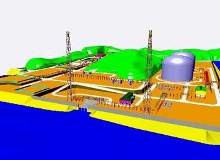
Phase I of the Guangdong Liquefied Natural Gas (LNG) and Trunkline Project involved the construction of China’s first LNG terminal and associated high-pressure gas pipelines to supply Guangdong Province with LNG.
The project was first launched in 2002 and construction of the terminal started in December 2003. It was completed in 2006 and the first LNG was produced by May 2006. However, commercial operations started in September 2006.
Additional gasification equipments and auxiliary facilities were added subsequently and the project’s annual turnover capacity has now increased to 6.8 million tonnes (3.7 million tonnes a year when commissioned).
The project is jointly developed by China National Offshore Corporation (CNOOC, 33%), Guangdong Province consortium (31%), which includes Shenzen Investment Holding Company, Guangdong Electric Power Holding Company, Guangzhou Gas Company, Dongguan Fuel Industrial General Company and Foshan Municipal Gas General Company, British Petroleum Amoco (30%), Hong Kong Electric and Light Company (3%), and Hong Kong and China Gas Corporation (3%).
The Guangdong Dapeng LNG Company (GDLNG) was created in February 2004 to oversee the construction and operations of the project.
Jones Day was the legal advisor for the project. The overall cost for the construction of the two facilities is estimated to have exceeded CNY8bn (approximately $1.29bn).
Pre-construction activities
The feasibility study report (FSR) was submitted to the National Development and Reform Commission (NDRC) of the provincial government in April 2003. Environmental and social impact assessment (ESIA) was carried out by Atkins of Hong Kong. The FSR and the budget were passed by the provincial government during the second quarter of 2003, allowing the appointment of contractors for the Phase I construction to be started.
Early site preparation by CNOOC started in May 2003 with the cooperation of the Shenzen Planning Bureau, Land and Resources Bureau, Construction Bureau and the Logistics Department of Guangdong Military Zone.
China’s first LNG import terminal and trunkline project details
The first phase of the project involved the construction of the LNG import terminal capable of berthing LNG carriers with a capacity of 217,000m3, three LNG storage tanks, regasification plant, the associated marine engineering works and more than 400km of trunkline system.
The LNG terminal is located at Ping Tou Jiao on the Dapeng Peninsula in Dapeng Bay in an area of 40ha. The trunkline traverses Shenzhen, Huizhou, Dongguan, Foshan and Guangzhou, with 20 offtake stations and 24 valve rooms situated along the entire route.
The trunkline has two lateral branch pipelines to connect to two new gas-fired power stations and three converted oil-fired power stations in China. In addition, a lateral pipeline delivers LNG to a gas-fired power station owned by Hong Kong Electric and Light Company and also to the Hong Kong and China Gas Corporation.
LNG supply contract for Phase I
Bids were invited for the supply contract for the new LNG terminal in Guangdong province from September 2000 by the provincial government. Australia-based consortium North West Shelf (NWS) Venture won the contract in August 2002. The export deal is worth A$25bn over the supply period, which has been set at 25 years (3.7 million tonnes a year).
The consortium includes Shell, BP, Chevron, BHP (Australia), Woodside, MiMY and CNOOC.
The Dapeng Sun, Dapeng Moon and Dapeng Star vessels ship the LNG to the terminal. The vessels are operated by China LNG Shipping (International) (CLSICO), a joint venture between COSCO, China Merchants and BP Shipping.
Contractors involved
The front end engineering design (FEED) contract was awarded to Halliburton KBR and JGC Corporation of Yokohama, Japan. The conceptual design was carried out by MW Kellogg in London, UK.
The STTS Group, a French / Italian joint venture of Saipem, Technigaz and the engineering companies Tecnimont and Sofregaz, was awarded the engineering, procurement and construction (EPC) lump-sum turnkey contract for the project.
China Petroleum Pipeline Engineering (CPPE) performed the engineering works for the pipeline and off-take stations, and collaborated with Sichuan Petroleum Pipeline Engineering (SPPE), Huabei Petroleum Pipeline Engineering (HPPE) and Liaohe Petroleum Field Engineering (LPFE) during the construction phase.
The civil works for the project were performed by CNEC. Safety systems were supplied by Safety Systems Engineering.
Insulation works for the LNG tanks were performed by Amol Dicalite.



